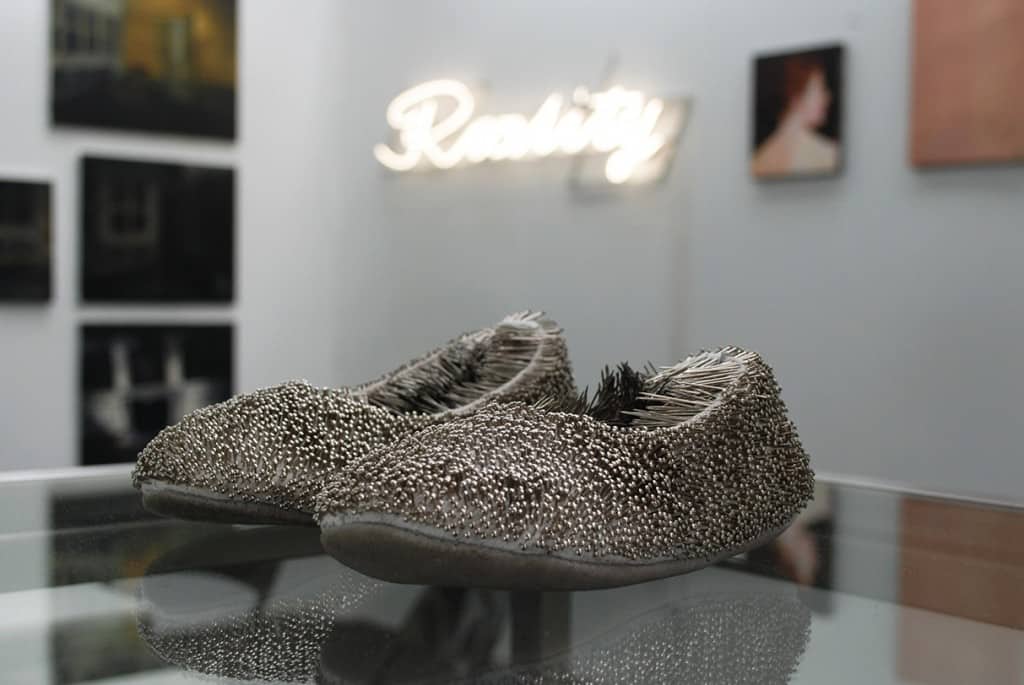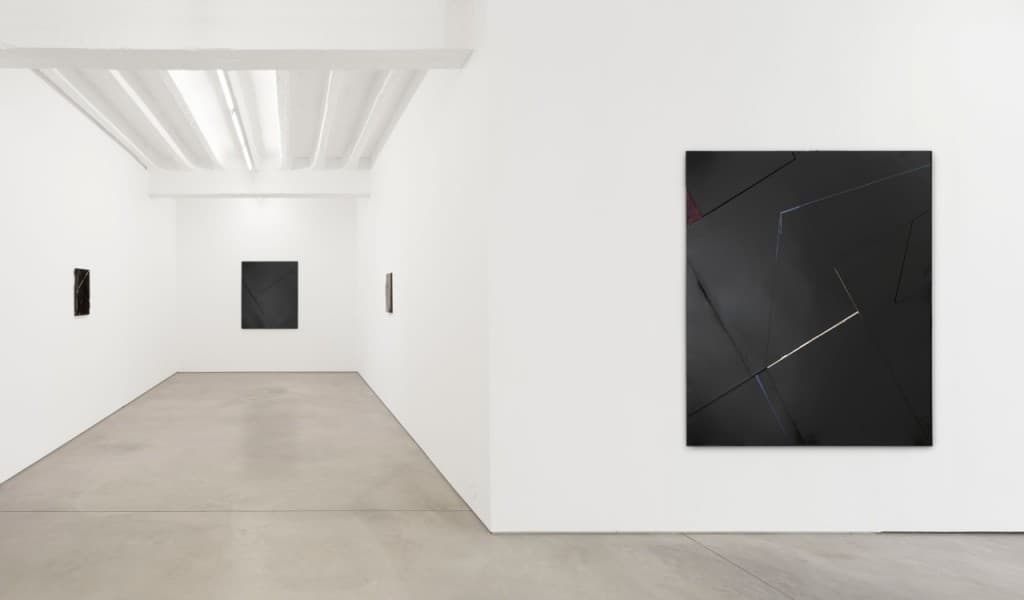The 3rd edition of Berlin Art Week (BAW) surprised with its scale and ambition. For the first time, the event’s programme included art fairs and exhibitions in public institutions but also commercial galleries as well as independent nonprofit initiatives and project spaces. Exhibitions were accompanied by talks, performances, workshops and discussions for every need or taste.

Piktogram Gallery, works of Cezary Poniatowski, abc art fairs, Courtesy of the Piktogram Gallery, September 2014
From the beginning the most important parts of BAW are art fairs: abc, Positions Berlin and Berliner Liste (which this year was not included in official programme). These fairs present galleries from outside of Berlin and lure collectors and art lovers to the city. Also for the first time, the event grew from a weekend fair into a week-long fest. As part of ABC Galleries Night in two evenings the galleries from various Berlin districts opened their doors for guests of BAW.
This edition was very fruitful for artists and galleries from Poland which showed a wide range of Polish art – from works by household names to young emerging artists never presented in Berlin before.
A number of galleries from Poland, and Warsaw in particular, took part in abc art fairs. The fairs took place – as always – in Station-Berlin on Luckenwalder Straße, which was the central venue of the BAW hosting a number of additional events.
The concept of abc, the leading Berlin art fairs after the closure of Art Forum, was to move away from traditional art fair form of space divided into exhibition booths. Instead, each participating gallery used an open space, which galleries could manage freely. This approach encourages galleries to present non-traditional art forms. In unorthodox space, galleries which opt to present traditional forms of paintings, drawings or photography need to find new ways to display works. In both cases, the creative challenge was to present art works in such a way that they stand out among other presentations.
Piktogram gallery took the risk and brought to Berlin a series of black and white paintings of young but already successful artist Cezary Poniatowski. His works were hung on a special construction, the elements of which resembled a garden arbour with a decorative arch to pass through.
Leto Gallery presented an installation made by Paris-based artist Angelika Markul. The installation “Untitled” was made of various materials, such as metal, wax, felt and leather partially hung on the white partition walls and partially put in glass-cases. The use of partitions helped to separate the installation from the rest of the space and create an intimate, white-cube like environment.
Another Warsaw gallery – lokal_30 – came to abc with works by Zuzanna Janin and Natalia LL. One simple partition wall divided an exhibition in two. One side was devoted to Zuzanna Janin “Yellow Pictures” – a series of four painting-like objects, made out of sand paper and sound. These objects were accompanied by an installation which has never been shown before – “VOLVO 240 transformed into 4 drons”, and as a title suggest was made from an old car. The other part lokal_30’s space was occupied by Natalia LL’s two large-scale photographs from the series “Body Topology” made in 1967.

Agnieszka Rayzacher, Natalia LL & Zuzanna Janin in front of Natalia LL’s work Body Topology, 1967,
photography, digital print, 2 pieces, abc art fairs, Courtesy of the Lokal_30 Gallery, September 2014
Stereo gallery presented a sound installation by Wojciech Bąkowski – “The Interval of Remembering” and a selection of his video works. The sonic nature of the installation meant that the gallery was given space to the side of the open hall, in a niche. In this case, being slightly removed from the other exhibitions created an ideal environment for the work and its reception.
In parallel, the second art fair – Positions Berlin, took place on the opposite part of the city, on Brunnenstrasse, in a rundown XIX century department store, which has been unused and empty for years. These new fairs, definitely smaller than the previous Preview fairs, concentrated mostly on German galleries, which offer traditional forms of art. Unlike abc, these fairs are a traditional set-up with galleries exhibition works in booths.
Thanks to the DNA gallery from Wrocław these fairs also included Polish presence. The gallery presented a selection of paintings by Grzegorz Klimek – young artist based in Wrocław. The presented series consisted of reduced forms of human body or common objects, put on a monochromatic background. As the gallerist informed, the works are made only from the paint prepared by using old methods of mixing and by the artist himself.
Berlin Liste, the third of the Berlin art fairs, was not included in this year’s official programme of BAW. Nevertheless, it is impossible not to mention them, because of the presence of two Polish galleries – Zderzak gallery from Kraków and Apteka Sztuki from Warsaw – and artist Tomasz Milewski presented by German gallery – Wolfram Völcker Fine Art.
For the second year in a row, Zderzak gallery presented works of Łukasz Stokłosa and Erwina Ziomkowska. The former’s works were a series of obscure palace interiors supplemented by melancholic portraits of Rimbaud (represented by Leonardo di Caprio) and Ludwig II of Bavaria (represented through Helmut Berger). Erwina Ziomkowska works included two pairs of shoes carefully studded with the needles and a neon work “Reality”. Zderzak also showed works by two painters – Cyryl Polaczek and Karolina Jabłońska. Both artists recently graduated from the Academy of Fine Art in Kraków and celebrated their debuts in Berlin.

Zderzak Gallery, work of Erwina Ziomkowska, Berliner Liste, Courtesy of the Zderzak Gallery, September 2014
Warsaw gallery Apteka Sztuki showed paintings by artists of two different generations. The young generation was represented by recent graduate Magdalena Jędrzejczyk and her series of simple Polish country scenes. Łukasz Rudnicki, assistant professor at the Academy of Fine Arts in Warsaw, presented a different approach towards painting and art in his ships paintings. Paintings, reduced only to use of black and white, present ships from bird’s eye perspective and remind of popular children play.

Apteka Sztuki, works of Magdalena Jędrzejczak & Łukasz Rudnicki, Berliner Liste,
Courtesy of Apteka Gallery, September 2014
Polish artists and their art works were also present outside of the official art fairs and were exhibited in various galleries. During first ABC Gallery Night, ŻAK|BRANICKA gallery presented a solo exhibition of Dominik Lejman works. The exhibition, entitled “dis/connected” consisted of Lejman’s new works, in which the artist applies his unique method combining traditional medium of painting with a video projection.
In the same building, two floors beneath the ŻAK|BRANICKA gallery, in Jochen Hempel gallery another Polish artist opened her show. For the first time, the gallery presented large scale paintings of Natalia Załuska, a graduate of art history in Kraków and fine arts at the Vienna Academy of Fine Arts. “The artist disturbs the painting’s monochromatic silence by a radical cut into the surface’s fabric, thus activating the planes and generating a sensual polylogue between the layers. Simultaneously nonchalant and controlled, her work is both smooth and violent, still and conversational, minimal and neobaroque.” writes Adam Budak in an accompanied text.
The rich programme of Berlin Art Week 2014 charged the city with plenty of art energy. It is evident that Berlin Art Week became an integral part of cultural calendar of the German capital. While Polish art is close geographically, in many aspects it is still relatively absent in Berlin. Polish presence at the Berlin Art Week on so many levels and in so many different forms was a positive sign. Hopefully, one for the future as well.
Paulina Olszewska is an art critic and curator who lives and works in Berlin. She studied art history at the Jagiellonian Univesity in Kraków (PL) and at the Humboldt Universität zu Berlin. She reviews for Obieg, Polish art magazines and her essays on contemporary art and architecture have been published in several magazines, including Atlántica, Architectura & Biznes, VLNA, MOCAK Forum and The Naked. Primarily devoted to emerging European art, she has contributed to catalogues and other art publications. She is a part of artists archive Berlinerpool.

Zderzak Gallery, works of Erwina Ziomkowska, Łukasz Stokłosa, Cyryl Polaczek & Karolina Jabłońska, Berliner Liste, Courtesy of the Zderzak Gallery, September 2014

Piktogram Gallery, works of Cezary Poniatowski, abc art fairs, Courtesy of the Piktogram Gallery, September 2014

Zuzanna Janin, Yellow Pictures, 1999-2014, 4 Objects, wood, sand paper and sound digital files & VOLVO 240 transformed into 4 drons, 2014, Scrap body of Volvo240, dimensions variable, abc art
fairs, Courtesy of the gallery, September 2014











